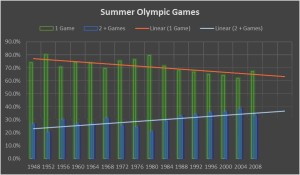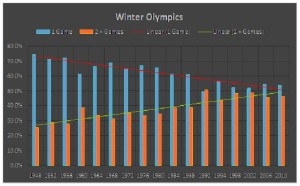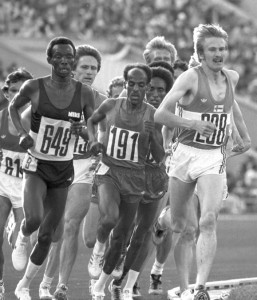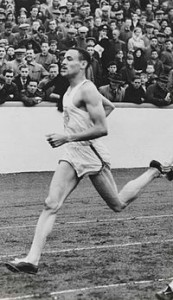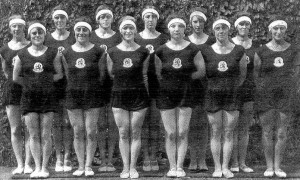The US Olympic marathon trials were held today and Meb Keflezighi made his fourth Olympic team. Meb won a bronze medal in the 2004 Olympic marathon and will be 41 years old on the day of the 2016 Olympic marathon. Much is being made about his age – how does it stack up against previous Olympic marathoners?
Meb Keflezighi
On the day of the Olympic marathon in Rio, Meb will be 41 years, 108 days old (41-108). That’s relatively ancient for a world-class marathoner, but far from unheard of. In fact, there have been 21 Olympic men run the Olympic marathon at an older age, led by Canadian Percy Wyer, who ran the 1936 marathon when he was 52-years-old. Here is the top 25 through 2012:
[table]
Age,name,year,noc
52-199,Percy Wyer,1936,CAN
48-196,Bohumil “Boris” Honzátko,1924,TCH
46-135,Haile Satayin,2008,ISR
45-246,Toni Bernadó,2012,AND
44-195,Percy Wyer,1928,CAN
44-069,Jack Foster,1976,NZL
44-017,Wally Hayward,1952,RSA
43-023,Luis López,1992,CRC
42-240,Ion Pool,1900,GBR
42-194,Roman Kejžar,2008,SLO
42-140,Haile Satayin,2004,ISR
41-345,Wallace Williams,1988,ISV
41-258,Toni Bernadó,2008,AND
41-235,Panagiotis “Peter” Trivoulidis,1920,GRE
41-235,Eusebio Guiñez,1948,ARG
41-206,Ville Kyrönen,1932,FIN
41-206,Andrés Espinosa,2004,MEX
41-204,Harold Webster,1936,CAN
41-201,William Saward,1900,GBR
41-166,Baba Ibrahim Suma-Keita,1988,SLE
41-148,Jack Holden,1948,GBR
40-352,Cristea Dinu,1952,ROU
40-336,Johnny A. Kelley,1948,USA
40-309,Mikko Hietanen,1952,FIN
40-185,Franjo Mihalić,1960,YUG
[/table]
What about among US men Olympic marathoners, you surely are asking? Meb will become the oldest American man to run the marathon at the Olympics, with the current oldest being Johnny “The Elder” Kelley at London in 1948. Meb’s 2012 London marathon already put him 6th oldest among US men. Here is the US top 10 list:
[table]
Age,name,year,noc
40-336,Johnny A. Kelley,1948,USA
40-104,Jimmy Henigan,1932,USA
40-059,Clarence DeMar,1928,USA
38-321,Billy Churchill,1924,USA
38-235,Albert “Whitey” Michelsen,1932,USA
37-099,Meb Keflezighi,2012,USA
36-102,Jimmy Henigan,1928,USA
36-036,Clarence DeMar,1924,USA
35-241,Tom Jones,1952,USA
35-223,Abdi Abdirahman,2012,USA
[/table]
This will be Meb’s third Olympic marathon, after 2004 and 2012 – he ran the 10,000 metres in 2000. Have any marathoners ever competed in more Olympic races? Yes, in fact, Andorran Toni Bernadó and Romanian Lidia Şimon ran 5 Olympic marathons from 1996-2012. Here is the list of all those running 4 or more Olympic marathons:
[table]
###,name,gender,noc,Yr1,Yr2,Yr3,Yr4,Yr5
5,Toni Bernadó,M,AND,1996,2000,2004,2008,2012
5,Lidia Şimon,F,ROU,1996,2000,2004,2008,2012
4,Karel Lismont,M,BEL,1972,1976,1980,1984
4,Baikuntha Manandhar,M,NEP,1976,1980,1984,1988
4,Rob de Castella,M,AUS,1980,1984,1988,1992
4,Ahmed Salah,M,DJI,1984,1988,1992,1996
4,Lisa Martin-Ondieki,F,AUS,1984,1988,1992,1996
4,Lorraine Moller,F,NZL,1984,1988,1992,1996
4,Steve Moneghetti,M,AUS,1988,1992,1996,2000
4,Erika Olivera,F,CHI,1996,2000,2004,2012
4,Lee Bong-Ju,M,KOR,1996,2000,2004,2008
4,Pavel Loskutov,M,EST,1996,2000,2004,2008
4,Viktor Röthlin,M,SUI,2000,2004,2008,2012
[/table]
Shalane Flanagan will also run in her 4th Olympics, after racing the 5K in 2004, the 5 and 10K in 2008, and the marathon in 2012. Flanagan will be 35 years old in Rio. How does that stack up against female Olympic marathoners in terms of senescence? Here are the lists for the top 25 oldest women to run the Olympic marathon and the USA top 10 list:
[table]
Age,name,year,noc
48-234,Lourdes Klitzkie,1988,GUM
46-284,Joyce Smith,1984,GBR
46-236,Evy Palm,1988,SWE
43-083,Irina Bogacheva,2004,KGZ
42-195,Sue Hobson,2000,AUS
42-194,Constantina Tomescu,2012,ROU
41-141,María Luisa Muñoz,2000,ESP
41-058,Lorraine Moller,1996,NZL
40-298,Garifa Kuku,2000,KAZ
40-297,Ivana Sekyrová,2012,CZE
40-130,Colleen de Reuck,2004,USA
39-347,Irina Mikitenko,2012,GER
39-299,María Elena Espeso,2012,ESP
39-256,Priscilla Welch,1984,GBR
39-251,Francie Larrieu-Smith,1992,USA
39-159,Pauline Curley,2008,IRL
39-157,Rhonda Davidson-Alley,2000,GUM
39-116,Irina Bogacheva,2000,KGZ
39-077,Gaby Andersen-Schiess,1984,SUI
39-052,Liza Hunter-Galvan,2008,NZL
38-357,Mara Yamauchi,2012,GBR
38-335,Lidia Şimon,2012,ROU
38-251,Magda Ilands,1988,BEL
38-232,Nelly Chávez,1984,BOL
38-206,Constantina Tomescu,2008,ROU
[/table]
[table]
Age,name,year,noc
40-130,Colleen de Reuck,2004,USA
39-251,Francie Larrieu-Smith,1992,USA
37-349,Chris Clark,2000,USA
35-183,Deena Drossin-Kastor,2008,USA
35-082,Linda Somers,1996,USA
35-015,Magda Lewy-Boulet,2008,USA
34-091,Nancy Ditz,1988,USA
34-027,Kara Goucher,2012,USA
33-024,Blake Russell,2008,USA
33-009,Jenny Spangler,1996,USA
[/table]
Colleen de Reuck
Flanagan’s 2012 Olympic marathon was done at age 31-028, putting her 13th on the US list for oldest female Olympic marathoners through 2012. She will be 35-037 on the day of the women’s Rio marathon and will move up to 6th among US Olympic marathoners, but she will not crack the top 25 for all nations.
